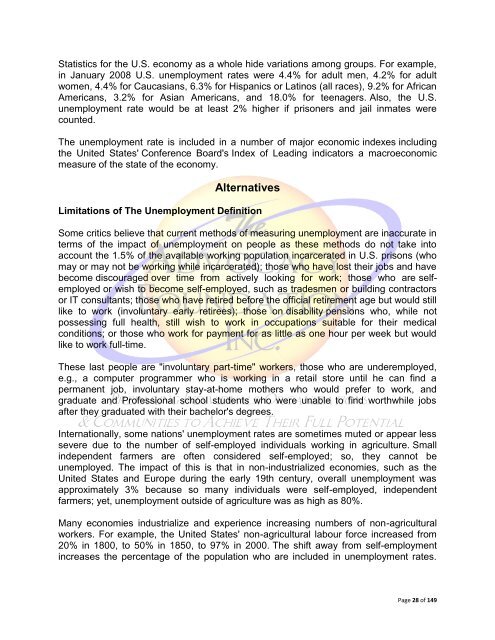Hidden Unemployment
Hidden Unemployment
Hidden Unemployment
Create successful ePaper yourself
Turn your PDF publications into a flip-book with our unique Google optimized e-Paper software.
Statistics for the U.S. economy as a whole hide variations among groups. For example,<br />
in January 2008 U.S. unemployment rates were 4.4% for adult men, 4.2% for adult<br />
women, 4.4% for Caucasians, 6.3% for Hispanics or Latinos (all races), 9.2% for African<br />
Americans, 3.2% for Asian Americans, and 18.0% for teenagers. Also, the U.S.<br />
unemployment rate would be at least 2% higher if prisoners and jail inmates were<br />
counted.<br />
The unemployment rate is included in a number of major economic indexes including<br />
the United States' Conference Board's Index of Leading indicators a macroeconomic<br />
measure of the state of the economy.<br />
Alternatives<br />
Limitations of The <strong>Unemployment</strong> Definition<br />
Some critics believe that current methods of measuring unemployment are inaccurate in<br />
terms of the impact of unemployment on people as these methods do not take into<br />
account the 1.5% of the available working population incarcerated in U.S. prisons (who<br />
may or may not be working while incarcerated); those who have lost their jobs and have<br />
become discouraged over time from actively looking for work; those who are selfemployed<br />
or wish to become self-employed, such as tradesmen or building contractors<br />
or IT consultants; those who have retired before the official retirement age but would still<br />
like to work (involuntary early retirees); those on disability pensions who, while not<br />
possessing full health, still wish to work in occupations suitable for their medical<br />
conditions; or those who work for payment for as little as one hour per week but would<br />
like to work full-time.<br />
These last people are "involuntary part-time" workers, those who are underemployed,<br />
e.g., a computer programmer who is working in a retail store until he can find a<br />
permanent job, involuntary stay-at-home mothers who would prefer to work, and<br />
graduate and Professional school students who were unable to find worthwhile jobs<br />
after they graduated with their bachelor's degrees.<br />
Internationally, some nations' unemployment rates are sometimes muted or appear less<br />
severe due to the number of self-employed individuals working in agriculture. Small<br />
independent farmers are often considered self-employed; so, they cannot be<br />
unemployed. The impact of this is that in non-industrialized economies, such as the<br />
United States and Europe during the early 19th century, overall unemployment was<br />
approximately 3% because so many individuals were self-employed, independent<br />
farmers; yet, unemployment outside of agriculture was as high as 80%.<br />
Many economies industrialize and experience increasing numbers of non-agricultural<br />
workers. For example, the United States' non-agricultural labour force increased from<br />
20% in 1800, to 50% in 1850, to 97% in 2000. The shift away from self-employment<br />
increases the percentage of the population who are included in unemployment rates.<br />
Page 28 of 149

















